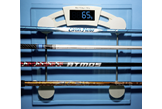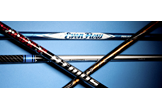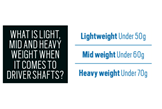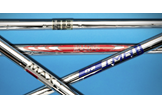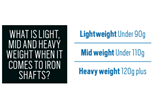REVIEW: Shaft weight
Published: Last updated:
Shaft weight has become more important than flex in the modern game… and this is why.
Shafts aren’t the first thing most club golfers think of when trotting off to buy a new driver or set of irons. But in 2018, brands now offer a wider selection of shaft weights (stock models) than ever before. It doesn’t matter whether you’re buying a driver or set of irons, shafts are neatly categorised into weight categories, but have you ever thought how much difference shaft weight makes, or which might suit you?
With 31g of difference between the latest shafts (stock models only, not including upgrade options) in Callaway and Ping’s newest drivers and irons (which is huge when it comes to maximising speed), we wanted to find out why shaft weight has become so important, and help you make a more informed buying decision.
We asked master clubfitter Jason MacNiven (who’s worked for Callaway and TaylorMade as a club fitting expert), who owns Golf Principles in Basingstoke. He offers custom fitting on all major brands, under one roof. He fits thousands of golfers a year, and has an intricate knowledge of the latest shafts. There’s no-one better to explain how different weight (and flexes) can affect your clubs.
The expert:

Jason MacNiven – Club – fitting expert and owner of Golf Principles
Review: Driver shaft weight

Just looking at the four biggest wood brands (Callaway, TaylorMade, Ping and Cobra) there are 34 different driver shaft weight options in 2018, and that’s before you even start looking at custom or upgrade options. In the past, great drivers came with a standard stock shaft in either a regular or stiff flex, but things have changed dramatically. MacNiven even says “shaft weight is more important today than shaft flex”, saying that “golfers can just about get away with playing the wrong shaft flex, but getting the wrong weight can absolutely kill your game”.
Think about it like this; each swing is individual to its owner and how the club is delivered at impact is different for everyone. A long, languid swing can create the same amount of speed as a short, punchy one, but how each loads the shaft is very different. A short, punchy swing might want a heavier shaft while the longer, languid one might well go into a lightweight model.
MacNiven says: “Getting the shaft weight wrong means you could hit shots horribly, with ball speed and dispersion being all over the place. It’s likely distance will go down, dispersion will go up.” But often golfers don’t even realise why they’re hitting those bad shots, which explains why shaft weight should be centre stage when considering a new driver.

HOW DO YOU CHOOSE YOUR IDEAL DRIVER SHAFT WEIGHT?
It goes without saying the best option is a decent custom fitting session with a proper club expert like Jason MacNiven (and a launch monitor) to understand how you launch drives into the air. But for any golfers who insist on self-medicating there are things you can do to help.
Feel the difference
MacNiven says: “Hit a light, mid and heavyweight shaft so you can feel the difference and gauge how different the results are. If light is good for you, you’ll feel the shaft is lively and responsive. If it’s too heavy, you’re likely to feel it’s hard work getting the club going and get the sensation you need your best swing to get decent results.”
Look at…
Which shaft weight gives the most consistently centred strike (often using a shorter driver shaft can help with this), the most club/ball speed and which gives the best dispersion.
Be prepared to give something up
Golfers can gain distance through a proper shaft weight fitting, but it might be at the expense of dispersion, or vice versa. The decision has to be driven by the player, not the fitter, so be honest about what ultimately you’re trying to achieve.
Once you’ve found your weight, dig into balance points
Potentially counter-balanced shafts can create more speed; they’re heavier at the grip end and lighter at the head, but not all golfers gain, as some lose the sensation of where the clubhead is. MacNiven adds: “For some, the hammer idea, where the head is heavier and you get more smash (like some of the long drive guys), is better. But it’s all about unlocking a golfer’s swing DNA characteristics, it’s not one size fits all.”
Review: Iron shaft weight

Ping are renowned for custom fitting and no matter which iron model you buy in 2018, you’ll be fitted into one of 20 shaft weights. Just like drivers, iron shafts vary massively in weight from 65g to 130g, and there’s different balance points (where weight is positioned within the shaft) to be considered, too, which means there’s so much choice out there, it’s easy to make the wrong decision.
MacNiven reckons he’s seen some players (and not always the best ones, either) who are so weight sensitive that just a 2-3g change in shaft weight alters their shot outcome. Equally, there are golfers who can’t feel a 15g difference, proving how important shaft weight has become. So while Dynamic Gold shafts were once seen as the hallmark of a premium iron, it’s highly unlikely their 125g weight is the perfect fit for many club golfers today.
If you do want to go down the custom route, MacNiven reckons it’s vitally important to strike up a good line of communication with a fitter. Give as much feedback as you can, and try to give like/dislike answers when trying different options. Within a few steps a decent fitter will unlock your best set-up. Quiz them on these three points (What weight shaft do I need? Where is the weight positioned? How stiff is the tip?) and you’ll walk away with a great set of irons.

HOW DO YOU CHOOSE YOUR IDEAL IRON SHAFT WEIGHT?
Where do Ascending Mass shafts fit in?
Ascending mass shafts turn original shaft thinking from a few years ago on its head. The long iron shafts are lighter (where they used to be heavier) to help maximise speed and launch, while the shorter iron shafts are heavier to more closely match your wedges. Jason says: “You need to try them as they’re like Marmite; they can work for golfers who like the feel.”
How do I decide between graphite or steel?
Because graphite and steel iron shafts can now be made to similar weights, it generally comes down to dispersion. Graphite has more torque (twist) which can help some golfers square the face at impact.
If I use a light shaft in my driver, should I play lightweight iron shafts?
Not necessarily. It’s important to treat both driver and iron shafts as individuals. For instance, PGA Tour winner Gary Woodland has a 55g difference between his driver and iron shafts, whereas Matt Kuchar is closer to 30g. Never assume, go through the fitting process – data doesn’t lie.
What should I do if I’m caught between regular and stiff flexes?
MacNiven says: “Go for the softer flex because it’s easier to shift. Look at it like an engine – if you’re constantly driving on the red line, the engine is going to blow at some time. It’s the same for a golf swing. You don’t want to feel like you have to swing at 110% every time to get a decent result.”
As you age you lose club speed each year
Golfers are getting older, and once you get over 60 you typically lose about 0.5mph of club speed per year. That’s without taking into account whether you’ve kept up your fitness or had injuries. So if you haven’t been fitted for five years you could easily have dropped 2.5mph of speed, which is hugely significant.


